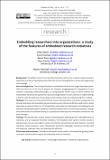Files in this item
Embedding researchers into organisations : a study of the features of embedded research initiatives
Item metadata
| dc.contributor.author | Ward, Vicky | |
| dc.contributor.author | Davies, Huw Talfryn Oakley | |
| dc.contributor.author | Reid, Benet | |
| dc.contributor.author | Tooman, Tricia Ray | |
| dc.contributor.author | Marshall, Martin | |
| dc.date.accessioned | 2021-05-17T11:30:10Z | |
| dc.date.available | 2021-05-17T11:30:10Z | |
| dc.date.issued | 2021-11 | |
| dc.identifier | 274051975 | |
| dc.identifier | 6e0777d8-f062-4b1a-a04b-8ef28b2120e7 | |
| dc.identifier | 85120793169 | |
| dc.identifier | 000729911300002 | |
| dc.identifier.citation | Ward , V , Davies , H T O , Reid , B , Tooman , T R & Marshall , M 2021 , ' Embedding researchers into organisations : a study of the features of embedded research initiatives ' , Evidence & Policy , vol. 17 , no. 4 , pp. 593-614 . https://doi.org/10.1332/174426421X16165177580453 | en |
| dc.identifier.issn | 1744-2648 | |
| dc.identifier.other | ORCID: /0000-0002-2653-3695/work/93514333 | |
| dc.identifier.other | ORCID: /0000-0001-8684-0403/work/93515152 | |
| dc.identifier.uri | https://hdl.handle.net/10023/23201 | |
| dc.description | This work was supported by the National Institute of Health Research (NIHR) Health Services & Delivery Research (HS&DR) programme under grant number 16/52/21. This research was undertaken as part of the EMBEDDED project funded by the NIHR Health Services and Delivery Research (16/52/21). | en |
| dc.description.abstract | Background : ‘Embedded research’ (co-locating researchers within non-academic organisations) is advocated as a way of developing more effective services through better creation and application of knowledge. Aims and objectives : The existing literature on embedded initiatives has largely been descriptive. There has been less in the way of analysis, for example, disaggregating the components of such schemes, unpacking underpinning logics, or comparing the diverse ways in which schemes are instantiated. We aimed to explore the nature and organisation of such schemes in health settings in the UK, with the objective of providing a systematised means of understanding their makeup. Methods : This study uses a focused literature review combined with a systematic scoping exercise of extant initiatives. We assembled documentation on each scheme (n=45) and conducted in-depth interviews in twelve of them (n=17). Analytically, we focused on surfacing and articulating the key features of embedded research initiatives in relation to their intent, structure and processes. Findings were then tested and validated during a co-production workshop with embedded researchers and their managers. Findings : We identified 26 ‘clusters’ of peer-reviewed papers detailing specific embedded research initiatives, and we explored 45 extant initiatives. The initiatives were varied in intent, structure and processes, but we were able to surface ten themes representing common features: intended outcomes, power dynamics, scale, involvement, proximity, belonging, functional activities, skill and expertise, relational roles, and learning and reflection. Discussion and conclusion : The themes uncovered can be used as a framework for guiding further systematic and evaluative enquiry on embedded research initiatives. | |
| dc.format.extent | 22 | |
| dc.format.extent | 248006 | |
| dc.language.iso | eng | |
| dc.relation.ispartof | Evidence & Policy | en |
| dc.subject | Embedded research | en |
| dc.subject | Healthcare organisations | en |
| dc.subject | Knowledge mobilisation | en |
| dc.subject | H Social Sciences (General) | en |
| dc.subject | E-NDAS | en |
| dc.subject.lcc | H1 | en |
| dc.title | Embedding researchers into organisations : a study of the features of embedded research initiatives | en |
| dc.type | Journal article | en |
| dc.contributor.institution | University of St Andrews. School of Management | en |
| dc.contributor.institution | University of St Andrews. School of Medicine | en |
| dc.identifier.doi | https://doi.org/10.1332/174426421X16165177580453 | |
| dc.description.status | Peer reviewed | en |
This item appears in the following Collection(s)
Items in the St Andrews Research Repository are protected by copyright, with all rights reserved, unless otherwise indicated.

